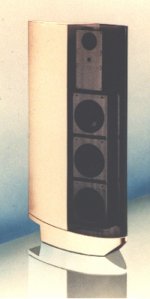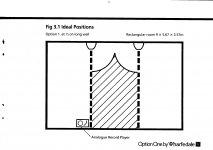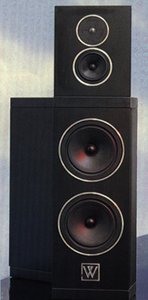Semi Transparent speaker drivers would look awesome for open baffle.
*clearer sound, more transparent
*clearer sound, more transparent
Sure thing... but I have to admit if I could hide or minimize the visual impact of the vertical and horizontal lumber that would make the drivers have a sort of "hover" effect. Might be cool. Something like acrylic or Lexan maybe? Still need to run wires up to the drivers somehow...
you can get wire with transparent coating. if you used silver colored wire it would minimalise the visual presence.
do you intend to use any baffle? Thick clearish plastic could work.
if not. one option would be clear plastic piping to suspend the drivers via thin wire. still visible to a degree however.
what about a taunt semiclear shower curtain with the drivers fixed in.
if not. one option would be clear plastic piping to suspend the drivers via thin wire. still visible to a degree however.
what about a taunt semiclear shower curtain with the drivers fixed in.
It seems you didn't get the memo...
no baffle... at all. That's what "nude" means (in this context).
no baffle... at all. That's what "nude" means (in this context).
I've tried a similar setup with a couple nude 18's per side, nude 10" mids, and hornless/chamberless compression drivers. Cleanest sound I've heard but very power hungry down low of course.
Juhazi, are you by any chance Juha Backman of
AES E-Library >> Computation of Diffraction for Loudspeaker Enclosures ?
If so, we may have corresponded on Dipole/Gradient speakers in the 80's when Wharfedale sold a large active Dipole speaker called Option 1
AES E-Library >> Computation of Diffraction for Loudspeaker Enclosures ?
If so, we may have corresponded on Dipole/Gradient speakers in the 80's when Wharfedale sold a large active Dipole speaker called Option 1
Last edited:
^Nope. I was a supporting member of AES Finnish section for some years and I have once briefly met Backman and I know his studies.
Nude hanging drivers I saw first in a post by StigErik in this long and informative thread
My open baffle dipole with Beyma TPL-150
In my AINOs the 12" has velcro strap on back of motor case, it sort of isolates the driver form rest of the system. Friends are worried about loosing some spl and increasing IMD because of inertia forces, the Mms is over 200 grams. That may be the case and my idol Gradient 1.3 has a steel frame to hold the low-midrange 12".
Nude hanging drivers I saw first in a post by StigErik in this long and informative thread
My open baffle dipole with Beyma TPL-150
In my AINOs the 12" has velcro strap on back of motor case, it sort of isolates the driver form rest of the system. Friends are worried about loosing some spl and increasing IMD because of inertia forces, the Mms is over 200 grams. That may be the case and my idol Gradient 1.3 has a steel frame to hold the low-midrange 12".
Here's an idea of what size dipole would be needed not to have loadsa bass boost.
This is an active dipole, 1.35m high 0.768m wide to be positioned against the back wall.
With floor & back wall images, the effective baffle is 4x the area; 2.7m high and 1.536m wide.
You listen to it well off-axis as in the 2nd pic. The 1/3 locations are ideal.
The bass dipole goes down to 35Hz in the room. There is some electronic EQ but nothing that I would call bass boost.
To go below that, you would need more drivers. Instead, the back part of the 'baffle' is a 90ltr ported subwoofer covering only 25-40Hz. It's switched off most of the time to have 100% dipole bass. The sound is usually unchanged but instruments like cellos & double basses seem to move if the sub is on.
The last pic is Option 2 about 3/4 the height of Option 1 but about the same width. This needed 10dB (IIRC) bass boost for flat in-room response to 35 or 40Hz.
I'm somewhat hesistant to post this as the speaker is heretical on so many fronts. But it represents (among other things) one elegant & successful, if expensive integration of speaker and room. Here, I present it as data on the size of baffle required for a given in room LF response without bass boost.
This is an active dipole, 1.35m high 0.768m wide to be positioned against the back wall.
With floor & back wall images, the effective baffle is 4x the area; 2.7m high and 1.536m wide.
You listen to it well off-axis as in the 2nd pic. The 1/3 locations are ideal.
The bass dipole goes down to 35Hz in the room. There is some electronic EQ but nothing that I would call bass boost.
To go below that, you would need more drivers. Instead, the back part of the 'baffle' is a 90ltr ported subwoofer covering only 25-40Hz. It's switched off most of the time to have 100% dipole bass. The sound is usually unchanged but instruments like cellos & double basses seem to move if the sub is on.
The last pic is Option 2 about 3/4 the height of Option 1 but about the same width. This needed 10dB (IIRC) bass boost for flat in-room response to 35 or 40Hz.
I'm somewhat hesistant to post this as the speaker is heretical on so many fronts. But it represents (among other things) one elegant & successful, if expensive integration of speaker and room. Here, I present it as data on the size of baffle required for a given in room LF response without bass boost.
Attachments
Last edited:
Here's an idea of what size dipole would be needed not to have loadsa bass boost.
This is an active dipole, 1.35m high 0.768m wide to be positioned against the back wall.
With floor & back wall images, the effective baffle is 4x the area; 2.7m high and 1.536m wide.
You listen to it well off-axis as in the 2nd pic. The 1/3 locations are ideal.
The bass dipole goes down to 35Hz in the room. There is some electronic EQ but nothing that I would call bass boost.
To go below that, you would need more drivers. Instead, the back part of the 'baffle' is a 90ltr ported subwoofer covering only 25-40Hz. It's switched off most of the time to have 100% dipole bass. The sound is usually unchanged but instruments like cellos & double basses seem to move if the sub is on.
The last pic is Option 2 about 3/4 the height of Option 1 but about the same width. This needed 10dB (IIRC) bass boost for flat in-room response to 35 or 40Hz.
I'm somewhat hesistant to post this as the speaker is heretical on so many fronts. But it represents (among other things) one elegant & successful, if expensive integration of speaker and room. Here, I present it as data on the size of baffle required for a given in room LF response without bass boost.
It exists! Thank you for posting this 🙂 I had heard of its existence but never managed to see one. But please enlighten us on the heresy - there is always much to learn...
---
This is an active dipole, 1.35m high 0.768m wide to be positioned against the back wall.
---
Same postioning appears at this post by MITsound https://www.diyaudio.com/forums/multi-way/123512-ultimate-baffle-gallery-262.html#post5701535
It is questionable if near-wall dipole actually can be called a dipole. The sound projected against the wall gets huge boost and wins the fronside radiation. In measurements we could notice it's reversed polarity and group delay. Semi-nearfield measurement would most propably show nulling on-axis like on cardioid's backside.
This system was obviously presented by Wharfedale in '80s, but got forgotten very rapidly - no wonder. Goodmans and Wharfedale | Page 3 | pink fish media
This is an active dipole, 1.35m high 0.768m wide to be positioned against the back wall.
---
Same postioning appears at this post by MITsound https://www.diyaudio.com/forums/multi-way/123512-ultimate-baffle-gallery-262.html#post5701535
It is questionable if near-wall dipole actually can be called a dipole. The sound projected against the wall gets huge boost and wins the fronside radiation. In measurements we could notice it's reversed polarity and group delay. Semi-nearfield measurement would most propably show nulling on-axis like on cardioid's backside.
This system was obviously presented by Wharfedale in '80s, but got forgotten very rapidly - no wonder. Goodmans and Wharfedale | Page 3 | pink fish media
How and from whom did you hear about these mythical beasts? 🙂It exists! Thank you for posting this 🙂 I had heard of its existence but never managed to see one. But please enlighten us on the heresy - there is always much to learn...
No. MIT points his dipole at the back wall. I fire my dipole parallel to the back wall. He has all the yucky stuff you describe and gets no boost from the wall ... only yucky cancellation.---
This is an active dipole, 1.35m high 0.768m wide to be positioned against the back wall.
---
Same postioning appears at this post by MITsound https://www.diyaudio.com/forums/multi-way/123512-ultimate-baffle-gallery-262.html#post5701535
My arrangement gets this 🙂 MIT doesn't.The sound projected against the wall gets huge boost and wins the fronside radiation.
This is some of the yucky stuff MIT's arrangement gets. This doesn't happen with my arrangement.In measurements we could notice it's reversed polarity and group delay. Semi-nearfield measurement would most propably show nulling on-axis like on cardioid's backside.
Option 1 was really designed to astound & amaze at shows ... which it did very well. We sold 12 and just broke even .. which surprised me. I thought we would make a huge loss. 😱This system was obviously presented by Wharfedale in '80s, but got forgotten very rapidly - no wonder.
Option 2 was the domestic version. We didn't go ahead cos our real bread & butter was small speakers. We made & sold the most successful & the 2nd most successful speakers in Europe for more than 7 yrs .. which was the period when FBA members revealed their sales figures to other members.
I wouldn't do another speaker like this unless you twisted my arm. It's quite expensive & you need a large room. But it presented stereo better than anything before or since and it integrated nicely with the room if used as recommended.
Do you have any measurements? It would be interesting to see how it can behave as a dipole close to the wall
I measured it in the early 80s. I don't have copies today.Do you have any measurements? It would be interesting to see how it can behave as a dipole close to the wall
A dipole works when standing on the floor. The back wall is just another 'floor'. Remember my dipole isn't firing AT the back wall. It fires PARALLEL to the back wall. The floor & back images makes the effective baffle 4x the size of the original.
If you have a flat panel speaker like an ESL63, why don't you try it for yourself? It's easy to check a dipole's Fig-8 directivity on pink noise.
Where is that description from? Perhaps dipole sounds better than open baffle
I remember a quote by Rudolf Finke that constant directivity is the actual objective of an open baffle design (and not the lack of eg. "boxy sound"). And indeed a lot of open baffle designs converged to achieve CD.
Here is Atkinson's story fo playing with sideways dipole of Gradient Helsinki 1.5. Pretty tricky...
Gradient Helsinki 1.5 loudspeaker John Atkinson, November 2010 | Stereophile.com
Here Jorma Salmi himself

Gradient Helsinki 1.5 loudspeaker John Atkinson, November 2010 | Stereophile.com
Here Jorma Salmi himself

- Home
- Loudspeakers
- Multi-Way
- In Pursuit of a 20-20k Dipole Loudspeaker


